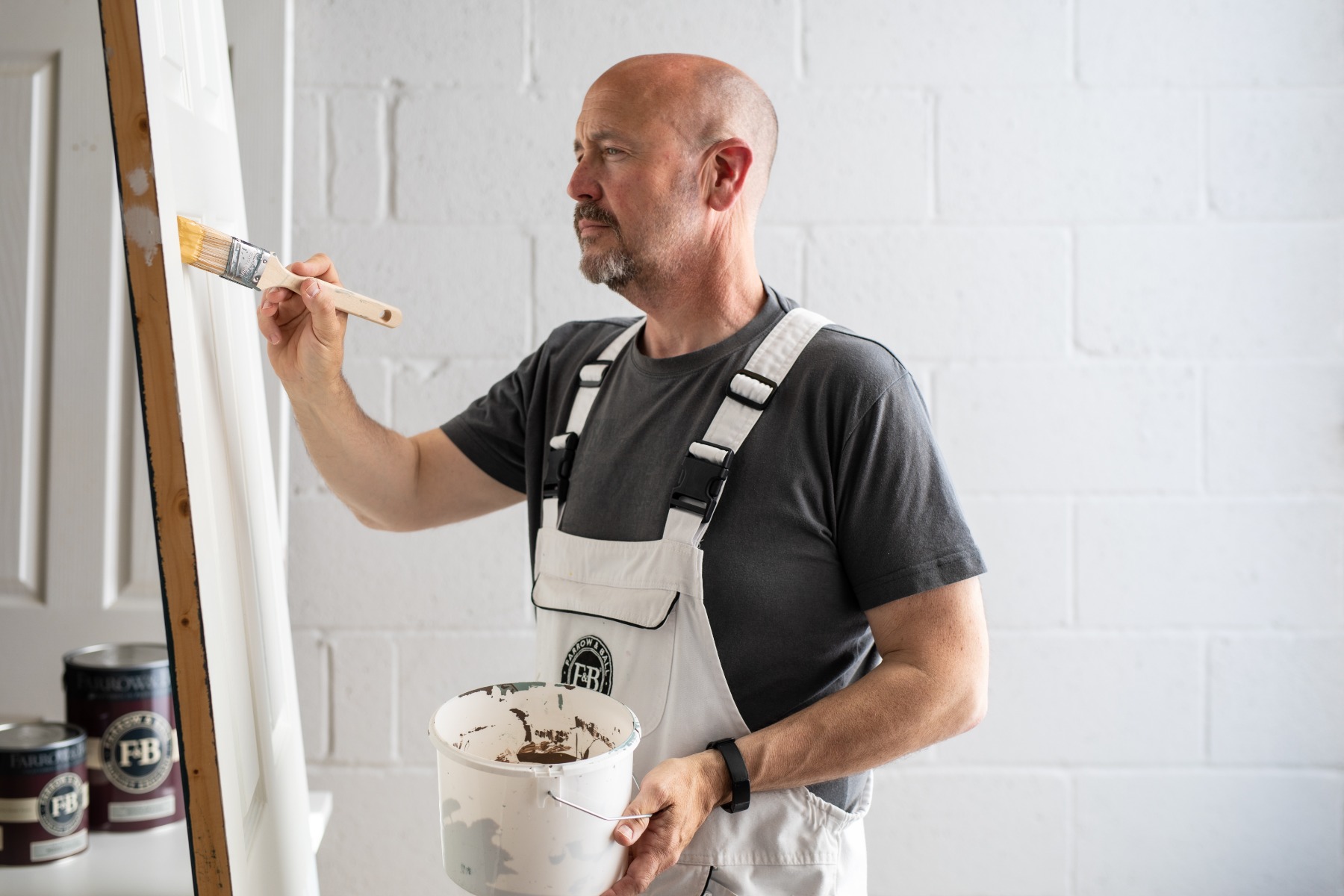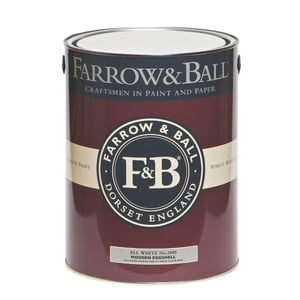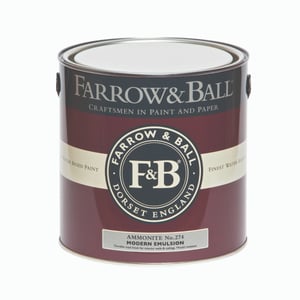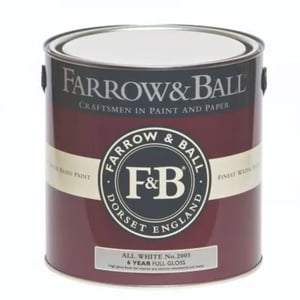How To Paint with Farrow & Ball
Once you’ve decided on your chosen Farrow and Ball colour and paint finish, you can get started on your project. Although painting a room is a fairly straightforward task it’s still essential to plan properly and know where to start to ensure you don’t miss any crucial steps in order to get the most professional finish.
Priming
Priming a surface before painting is crucial no matter what paint you are using. It can mean the difference between a professional finish which lasts and a mediocre one. It also promotes paint adhesion, improves sheen, protects the surface and helps cover stains. Farrow and Ball’s Primer and Undercoat are formulated with each of their colours and finishes in mind using the same high-quality natural ingredients. This undercoat is the crucial foundation for creating a rich, even and longer-lasting finish.
The Primer and Undercoats come in four different tones:
- Mid Tones
- Dark Tones
- White and Light Tones
- Red and Warm Tones
These tones have all been created to work with the full range of Farrow and Ball topcoat paint colours, adding richness and depth for that classic Farrow and Ball look.
You need to ensure you pick the right Primer and Undercoat for the surface you are painting.
- Wall and Ceiling Primer and Undercoat - designed for use under Estate Emulsion and Modern Emulsion finishes.
- Wood Floor Primer and Undercoat -formulated for use on interior wooden floors before applying a Modern Eggshell finish.
- Interior Wood Primer and Undercoat - designed for use on bare wood to help create a smooth base to build up a rich coat of Estate Eggshell, Full Gloss, Modern Eggshell or Dead Flat finishes.
- Metal Primer and Undercoat - this primer is intended for use on all bare, ferrous metal surfaces due to its rust-inhibiting properties. Designed to create a smooth foundation on surfaces such as gates, railings, furniture, radiators, and metal downpipes before using an Exterior Eggshell, Estate Eggshell, Full Gloss or Dead Flat top coat.
For best results, you should ensure the surface is completely free from dirt, dust, grime, mould, or anything else affecting the end result before you begin priming.
Once you are happy with the cleanliness of the surface you can move on to any repairs that need to be made. Small nicks and chips in interior walls can be repaired with general purpose or fine surface filler by filling the damage, scraping off the excess and smoothing flat when dry.
Before you start applying the primer, it is a good idea to protect your surroundings by removing all furniture and ensuring the room is well-ventilated.
Farrow and Ball recommend one coat of their Primer and Undercoat using a brush roller or airless spray, in the recommended tone. If you aren’t sure which tone you should use, you can find this on the back of your colour card, or on the product page for your chosen topcoat colour.

Prepping
Before you even pry open a tin of paint you should ensure the walls are in the right condition to be painted. This means you should check for damp, or if damp is suspected, get in a professional to assess the situation.
Once the wall is treated and in good condition, repairs should be made to the surface to ensure a nice even canvas to paint on. It is always best to remove picture hooks, shelves and so on prior to painting. Fill in any small to medium holes with polyfilla, scrape the excess using a scraper, wait for the filler to dry then sand with some fine or medium grit sandpaper- depending on the severity of the repair.
Make sure you vacuum any dust, particularly focusing on woodwork if you have sanded the walls as the dust will gather here.
Ideally the room would be empty before painting, but not everyone has the space for this to be possible so it is vital to protect furniture and surfaces.
If you can, remove any high value items. Your mattress and any electronics for example, if this isn’t possible ensure you cover with a dust sheet and make sure it is secured.
For the carpet/floor a material dust sheet is preferable to a plastic one. A plastic sheet will stick to the painters tape and tear when trying to remove and it is also a slippery surface which can lead to its own issues. Alternatively, flattened cardboard boxes, a carpet protector or hardwood floor protector are also great options for protecting the floor.
Next, protect your woodwork. Painters tape or masking tape isn’t vital if you have a steady hand, but for many it is nice to have that extra layer of protection. Painter’s tape should be placed on the parts you want to protect from paint, such as on the top of the skirting board, the door frame and around light switches and sockets. For the latter there is the option to unscrew the outlets but if this makes you uncomfortable taping around the edges, cutting a diagonal slit on each corner and folding the tape inwards is protection enough.
Painting
Once the primer has dried, apply two coats of your chosen paint colour using a brush or roller. For surfaces such as newly plastered and dry-lined walls, Farrow and Ball recommend a diluted layer of your chosen topcoat colour, followed by two full coats. Take care not to overwork the paint or stretch it out too thinly when applying.
It’s important you let the recommended drying time pass between each coat to ensure the best finish. Drying times differ for each finish so it’s crucial to check the individual product page.
Factors such as temperature, humidity and the shade being applied can also have an effect on Farrow and Ball drying times. Estate Emulsion and Modern Emulsion are usually dry in two hours and can be recoated in four hours.
If you need to use more than one tin of the same colour, make sure you check the batch numbers are the same on the base of the tin. If not then you should mix the two colours together before use and stir the paint thoroughly.
Once the room is ready to paint it's best to work from top to bottom, start on the ceiling and work your way down. Start by mixing your paint and then on a ladder cut in along the ceiling with a brush. Then using a roller attached to an extension pole you can paint the rest of the ceiling. Repeat this process when painting the walls, use a brush for edges then a roller, remember to work from the top to the bottom.
When painting wooden doors and windows use a small paintbrush, apply at least two coats of woodwork paint and remember to allow adequate drying time and sanding between coats. Make sure if you use a brush you spread out the paint evenly in a horizontal direction. To avoid brush marks, use long, gentle strokes in a single direction.
Last but not least is the skirting boards. After you have sanded any cracks and taped off where the wall and skirting meet, you should apply two coats of gloss, satin or eggshell paint with a small paintbrush. Carefully remove the tape and you are done!
er to view in the daylight to ensure you haven’t missed anywhere or don’t require another coat.
5 common painting mistakes
In order to get the most professional finish from your Farrow and Ball paint, avoid these common mistakes:
1. Assuming different tins of paint will be the same just because they are the same name and from the same manufacturer. If you have a big paint job ahead of you and you need to use several tins of paint it is better to invest in a large bucket with lid and mix the paints, this way you will have one consistent colour to work with, rather than potential variations due to the colours being mixed at different times.
2. Not choosing the right paint for the room- or for your lifestyle- The ‘wrong’ type of paint can either be the wrong finish or not knowing the best paint for each surface. Porous surfaces, such as fresh plaster and bare wood for example, would absorb too much of a water-based paint. For fresh plaster a contract matt or silk is advised, for bare wood a wood primer, undercoat and top coat is recommended prior to painting. Similarly, you need to know your finishes in order to select the right paint. Most paint brands will have a guide on their finishes on their websites. Also you need to take into consideration the use of the room, for example bathrooms are high moisture, kitchens are exposed to grease and a child’s room is likely to experience a lot of grubby hand and the occasional expression of creativity, making sure the paint you choose is suited to the space is vital for a long lasting result.
3. Over brushing the paint. Striving for perfection can often lead to mistakes when it comes to painting and one way is by over brushing. This means continuously brushing over the same part aiming for a smoother finish. However, by doing this you are more likely to cause unsightly drag marks in paint as the bristles cling to partially dry paint and force it to move. There is also more of a risk of losing bristles this way, which can become stuck in the paint. Load the paint brush and quickly brush the paint across the surface in a smooth motion, using a stroke or two to level it off.
4. Waiting until the paint is dry to remove the painter’s/masking tape. Nothing worse than working for a clean finish only to pull up the tape and see chunks of your hard work go with it. Do not wait until the paint is completely dry to remove the tape, remove it while the paint is damp for a clean, professional finish.
5. Not locking pets out of the room being decorated. Unless part of your plan for the room is to have paw and nose prints over everything within reach, make sure beloved furry family members are kept out of the way of spaces being painted. Plus, you won’t want wayward fur making its way into the paint and spoiling the smooth finish you prepped so hard for.





